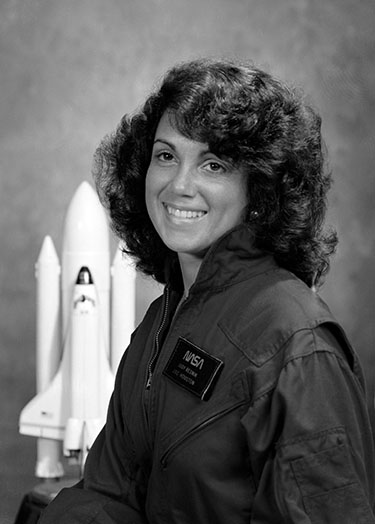
Judith A. Resnik (April 5, 1949–January 28, 1986) was born in Akron, Ohio, to optometrist Marvin Resnik and his wife Sarah Polensky, a legal secretary. She grew up in an observant Jewish home, studying Hebrew at Beth El Synagogue and celebrating her bat mitzvah in 1962. She was outstanding in secular school, excelling in mathematics, languages and piano. She attained a perfect score on the Scholastic Aptitude Test, only the 16th woman to do so in the history of the test. She was valedictorian of Harvey S. Firestone High School. After her parents divorced, Resnik’s mother was awarded custody, but Resnik filed a successful lawsuit to have custody switched to her father, who had remarried.
Resnik was a member of Alpha Epsilon Phi sorority at Carnegie Institute of Technology, where she switched her major to electrical engineering. She had a reputation as a gourmet cook and the navigator at sports car rallies, in which she participated with her future husband Michael Oldak, whom she married in 1970, the year of her graduation. Husband and wife were hired by RCA, where she designed circuitry for radar control systems, rockets, and telemetry systems. When Oldak was accepted to Georgetown University Law Center, she pursued a master’s degree and a doctorate at the University of Maryland, becoming a research fellow in biomedical engineering at the National Institutes of Health. She and Oldak divorced in 1975—he wanted children, she did not—but they remained on good terms.
A high school boyfriend, Len Nahmi, persuaded her to get a pilot’s license preparatory to applying to become an astronaut with the National Aeronautics and Space Administration (NASA). In the meantime, she moved to Redondo Beach, California to take a job as a senior systems engineer with the Xerox Corporation.
NASA accepted her in January 1978 for training as a mission specialist with Astronaut Group 8, one of 29 men and 6 women selected out of 8,028 applicants. Her salary was considerably less than what she earned at Xerox. At NASA, she developed software and operating procedures for the Space Shuttle’s Remote Manipulator System. She disliked doing interviews, especially when they delved into her personal life. Sally Ride was chosen to be the first woman in space, partly because she was more comfortable being in the public eye. In February 1983, Resnik was assigned to the crew of the 12th Space Shuttle flight, which would be the maiden voyage of the Space Shuttle Discovery, along with Henry Hartsfield, Michael Coats, Steven Hawley and Mike Mullane.
Three times the launch of Discovery was aborted before it lifted off on August 30, 1984, making Resnik the second woman and first American Jewish astronaut to go into space. The crew deployed three satellites respectively for Satellite Business Systems, the U.S. Navy, and Telesat of Canada, as well as a solar array wing to gather more electrical power for space missions. She spoke in a live televised broadcast with President Ronald Reagan during the 6-day mission, telling him “I couldn’t have picked a better crew to fly with.”
On January 29, 1985, she was selected to fly aboard the Space Shuttle Challenger, which had several responsibilities to prepare for, including launching a tracking and data relay satellite, and use of spectrometers to study the tail of Comet Halley. The mission lifted off from Kennedy Space Center one year minus a day later, breaking up a minute later as a result of the failure of an O-ring on the starboard solid rocket booster. The cabin remained intact until it hit the water at 207 miles per hour, killing all aboard. Navy divers recovered her remains, which were later cremated and scattered over the water.
Resnik was posthumously awarded the Congressional Space Medal of Honor. A crater on the Moon was named after her as was one on Venus. An asteroid 3356 Resnik was also named for her. Locally, Challenger Middle School recalls her memory.
Tomorrow, April 6: Emil Jellinek
*
SDJW condensation of a Wikipedia article.